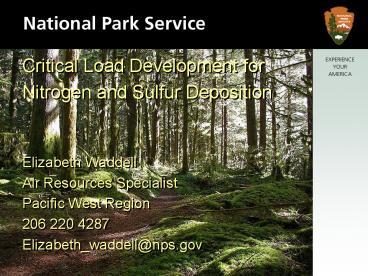Critical Load Development for - PowerPoint PPT Presentation
1 / 19
Title:
Critical Load Development for
Description:
Critical Load Development for Nitrogen and Sulfur Deposition Elizabeth Waddell Air Resources Specialist Pacific West Region 206 220 4287 Elizabeth_waddell_at_nps.gov – PowerPoint PPT presentation
Number of Views:50
Avg rating:3.0/5.0
Title: Critical Load Development for
1
- Critical Load Development for
- Nitrogen and Sulfur Deposition
- Elizabeth Waddell
- Air Resources Specialist
- Pacific West Region
- 206 220 4287
- Elizabeth_waddell_at_nps.gov
1
2
Science Workshop
- Funded by NWCAA
- Co-sponsored by NWCAA, NPS, USFS, and USGS
- Focus on NW WA
- but applicability for
- most of R10
2
3
Participants
- Researchers with expertise in nitrogen and
sulfur effects on - Lichens
- Soil chemistry
- Vegetation
- Water chemistry
- Mycorrhizae
- Diatoms
- Deposition monitoring
- Deposition modeling
- Setting critical loads
3
4
Participants
- NPS Science Staff
- USFS
- NWCAA
- PSCAA
- Ecology
- Tribes
4
5
What is a Critical Load?
- the quantitative estimate of an exposure to one
or more pollutants below which significant
harmful effects on specified sensitive elements
of the environment do not occur according to
present knowledge.
5
6
What is a Critical Load?
N Deposition (kg/ ha /yr)
Natural background N deposition
Changes in tree and soil chemistry
Change in alpine plant species
Change in algal species
Effects on aquatic and terrestrial biota
(episodic or chronic acidification)
Increased NO3 in lakes
6
7
Critical Loads in Action
- Critical load work proceeding at Rocky Mountain
NP - 1.5 kg N/ha/yr for eutrophication effects of
alpine lakes - Current
- deposition
- is 3-4 kg
- N/ha/yr
- Partnering
- with CDPHE
- to identify
- sources and
- reduce
- emissions
7
http//www.cdphe.state.co.us/ap/rmnp.html
8
Current Knowledge Deposition Monitoring
- NADP Monitoring
- S deposition declining
- N deposition no trend
- Between 1 and 2 kg/ha/yr
- Does not include dry or occult deposition
- All low elevation sites
8
9
Current Knowledge NADP N Deposition Monitoring
9
10
Current Knowledge N Deposition Monitoring
Research
- Throughfall Monitoring
- Low under canopy
- Lichens absorbing N?
- High in bulk
- deposition
- Inconsistent
- with NADP or CG
- Snowfall
- Comparable to NADP
10
11
Current Knowledge Deposition Modeling Research
WSU CMAQ preliminary work based on 36 km grid
11
12
Current Knowledge Deposition Modeling Research
- Modeling
- Overpredicts dry
- Underpredicts wet
- No cloud
- Limited sensitivity
- analysis
12
13
Current Knowledge Ecological Effects
- Lichens
- Sensitive to air pollution
- N sensitive lichens absent in areas of high
nitrogen deposition - Preliminary work with Columbia Gorge throughfall
monitoring data yields a CL of 2.4 kg/ha/yr - 2.0 dry deposition
- 0.4 wet deposition
13
14
Current Knowledge Ecological Effects
- Acidification effects
- Nutrient effects of N expected to occur at lower
deposition rates than acidification effects - MAGIC model yielded an upper bound CL of 10 kg
S/ha/yr for acidification of Lake Eunice (Mt.
Rainier) - (Recent documentation of episodic acidification
at Lake Eunice due to snowmelt pulse)
14
15
Research Priorities
- Aquatic Ecosystems
- Mine existing water quality databases to
identify - Areas which may already be affected by N or S
deposition - Areas which may be sensitive to additional N
- Establish CL for eutrophication of aquatic
ecosystems using RMNP work as a model (diatoms)
15
16
Research Priorities
- Terrestrial Ecosystems
- Lichens
- Collect lichens from NADP and throughfall
sites - Refine deposition modeling and/or conduct
additional monitoring to better establish a
deposition gradient and/or use PRISM - Natural Resources Conservation Service (NRCS)
soils mapping effort - Identify sensitive areas (N and Al)
16
17
Research Priorities
- Terrestrial Ecosystems
- Alpine meadows
- Fertilization effects research using RMNP as
model - Mycorrhizal diversity
- Similar to lichens in terms of PNW ecological
importance and diversity.
17
18
Not a Research Priority
- Quantifying actual deposition
- Adequate to index to NADP or other standard
monitor
18
19
Questions?
19































